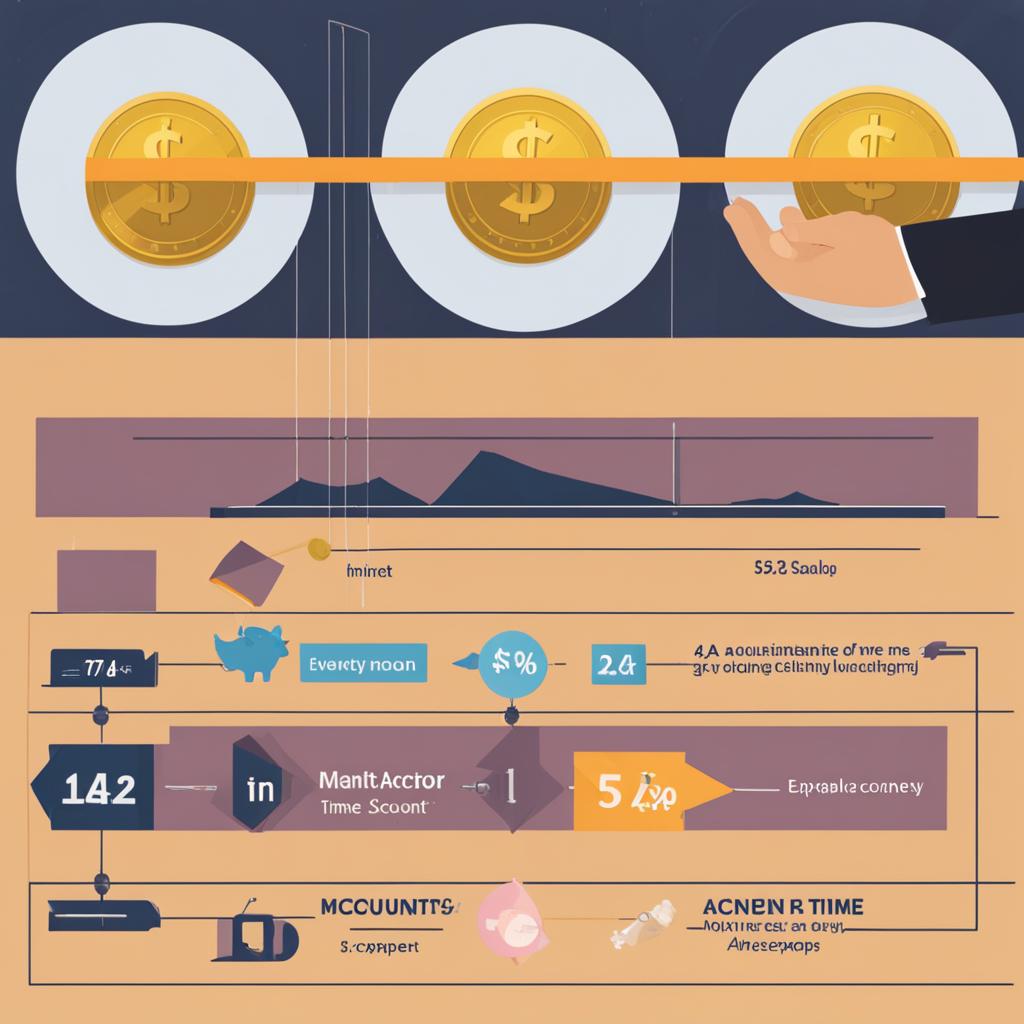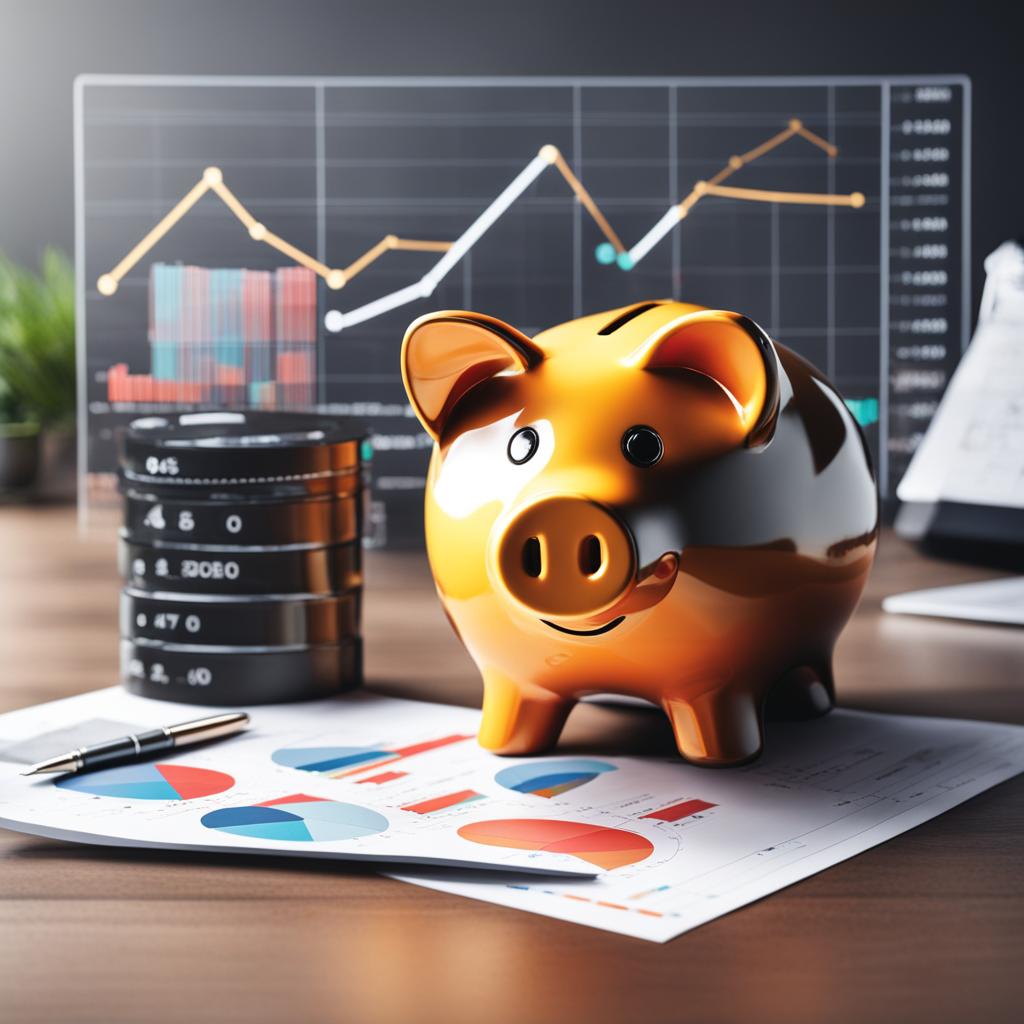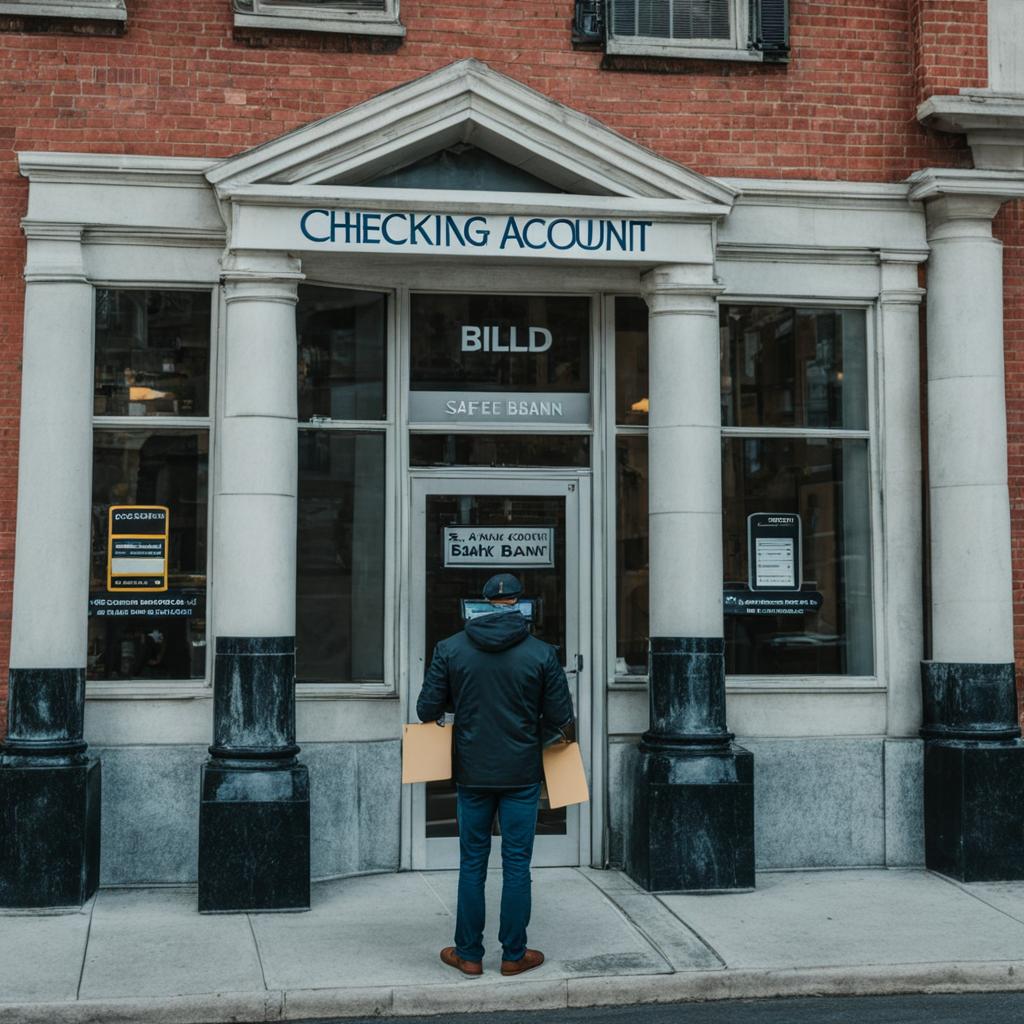A checking account buffer, also known as a cash cushion or mini emergency fund, is some extra cash that we keep in our checking account to protect against overdraft fees and ensure smooth financial management. It serves as a reserve fund for small unexpected expenses and offers peace of mind by preventing our account from being overdrawn. Building a checking account buffer is a fundamental step towards improving our financial situation and avoiding unnecessary fees.
Key Takeaways:
- A checking account buffer is extra cash kept in a checking account to protect against overdraft fees and manage unexpected expenses.
- It serves as a reserve fund and provides peace of mind by preventing the account from being overdrawn.
- Building a checking account buffer is essential for financial stability and avoiding unnecessary fees.
- The ideal buffer amount is between $500 and $1,000 or one to two weeks of take-home pay.
- Regularly monitoring and adjusting the buffer amount is important to suit changing financial needs.
The Importance of a Checking Account Buffer
A checking account buffer is crucial for financial stability and peace of mind. It provides numerous benefits that can significantly improve your financial well-being.
Protection against Cash Flow Fluctuations
One of the primary benefits of a checking account buffer is its ability to protect against minor cash flow fluctuations. It acts as a safety net, ensuring that you have enough funds to cover essential expenses, even when unexpected bills or expenses arise just before your paycheck deposits. With a buffer in place, you won’t have to worry about insufficient funds or resorting to high-interest credit cards to cover these expenses.
Avoidance of Overdraft Fees
Another crucial advantage of having a checking account buffer is the ability to avoid costly overdraft fees. When your checking account balance falls below zero, overdraft fees can quickly accumulate and become a financial burden. By maintaining a buffer, you can ensure that your account balance remains positive at all times and prevent unnecessary fees that can eat into your financial resources.
Confidence in Automatic Payments and Investments
Having a buffer in your checking account provides peace of mind when setting up automatic payments and investments. It acts as a cushion between your expenses and your account balance, reducing the risk of transactions failing or bouncing due to insufficient funds. With a checking account buffer, you can confidently automate your financial obligations, knowing that you have a buffer to cover any unexpected expenses that may arise.
Reduction of Financial Stress
Financial stress can be significant, impacting your overall well-being and mental health. A checking account buffer helps alleviate this stress by providing a financial safety net. Knowing that you have a buffer in place can reduce anxiety and give you the confidence to navigate unexpected financial challenges. It allows you to approach your finances with a sense of calm and control, enabling you to make better financial decisions and focus on your long-term goals.
Overall, a checking account buffer offers numerous benefits that contribute to your financial stability and peace of mind. It protects against cash flow fluctuations, helps you avoid overdraft fees, allows for confident automation of payments and investments, and reduces financial stress. Building and maintaining a checking account buffer is a vital step towards improving your financial situation and achieving your long-term financial goals.
| Benefits of a Checking Account Buffer |
|---|
| Protection against cash flow fluctuations |
| Avoidance of overdraft fees |
| Confidence in automatic payments and investments |
| Reduction of financial stress |
How to Set Up a Checking Account Buffer
Setting up a checking account buffer is a straightforward process. To ensure financial stability and peace of mind, follow these steps:
Step 1: Assess Your Financial Situation
Start by assessing your current financial situation. Take a look at your income, expenses, and savings to determine how much you can set aside as a buffer. This will help you establish a realistic goal for your checking account buffer.
Step 2: Determine the Buffer Amount
Determine the amount you want to keep as a buffer in your checking account. A good rule of thumb is to aim for between $500 and $1,000, or at least one to two weeks of take-home pay. However, this amount can vary based on your individual circumstances and comfort level.
Step 3: Adjust Based on Income and Expenses
Assess your income and expenses to determine the appropriate buffer amount for your checking account. Consider factors such as the stability of your income, the frequency of your expenses, and any upcoming financial commitments. Adjust your buffer amount accordingly to ensure you have enough funds to cover unexpected expenses.
| Income | Expenses | Checking Account Buffer |
|---|---|---|
| $3,000 | $2,500 | $500 |
| $5,000 | $4,000 | $1,000 |
Step 4: Build Your Buffer
Now that you have determined the ideal buffer amount, it’s time to start building your checking account buffer. Consider ways to cut expenses, such as reducing discretionary spending or negotiating bills. You can also explore earning extra income through a side hustle or freelance work. Additionally, consider using automated savings tools like Digit to make regular contributions to your buffer effortlessly.
Step 5: Monitor and Adjust
Regularly monitor your account balance to ensure it aligns with your buffer amount. Keep track of any changes in income or expenses that may require adjustments. Make it a habit to review your buffer on a monthly basis and make any necessary modifications to maintain an adequate safety net.
By following these steps, you can set up a checking account buffer that provides financial security and peace of mind. Remember, building a buffer takes time and effort, but the benefits far outweigh the initial investment. Start today and take control of your finances!
Strategies for Maximizing Your Checking Account Buffer
When it comes to optimizing your checking account buffer, there are several effective strategies you can implement to make the most out of this financial tool. By following these strategies, you can ensure that your buffer serves its purpose and provides you with the necessary financial security.
Track Your Expenses and Create a Budget
One of the most important strategies for maximizing your checking account buffer is to track your expenses and create a budget. By keeping a close eye on your spending habits, you can identify areas where you might be overspending and make necessary adjustments. Creating a budget allows you to allocate your funds more effectively, ensuring that you have enough money left to contribute to your buffer.
Here’s how you can create a budget:
- List all your income sources.
- Identify all your expenses, including fixed expenses (rent, utilities) and variable expenses (groceries, entertainment).
- Subtract your total expenses from your income to determine how much you can allocate to your buffer.
Maintain a Green, Yellow, and Red Zone System
Another useful strategy is to maintain a green, yellow, and red zone system in your checking account. This system helps you stay aware of your spending habits and prevents emergency situations where you might dip into your buffer unexpectedly.
Here’s how the system works:
- Green Zone: This represents your regular account balance. It’s the amount of money you ideally want to keep in your checking account for everyday expenses.
- Yellow Zone: This acts as a secondary balance for occasional overspending. When your account balance reaches the yellow zone, it serves as a reminder to exercise caution and review your budget.
- Red Zone: This indicates that you’re approaching your buffer. When your account balance reaches the red zone, it’s a signal to take immediate action and review your spending habits to avoid depleting your buffer unnecessarily.
Consider Automating Your Savings
Automating your savings is a powerful strategy that can help you consistently contribute to your checking account buffer. By setting up automatic transfers from your checking account to your savings, you ensure that a portion of your income goes directly towards building and maintaining your buffer.
Here are a few options for automating your savings:
Digit: Digit is an automated savings tool that analyzes your spending patterns and transfers small amounts from your checking account to your buffer. It adjusts its withdrawals based on your income and expenses, making saving effortless.
By implementing these strategies, you can optimize your checking account buffer and strengthen your financial foundation. When your buffer is well-managed, you’ll have peace of mind knowing that you have a financial safety net to cover unexpected expenses and avoid potential overdraft fees.
| Strategies for Maximizing Your Checking Account Buffer |
|---|
| Track Your Expenses and Create a Budget |
| Maintain a Green, Yellow, and Red Zone System |
| Consider Automating Your Savings |
Maintaining Your Checking Account Buffer
Now that you’ve established your checking account buffer, it’s important to maintain it to continue enjoying its benefits. Keeping a close eye on your budget and spending habits is key to ensure that you stay within your means and don’t overly rely on your buffer. It’s crucial to keep track of your account balance and be aware of any changes or unexpected expenses that may require adjustments to your buffer amount. By regularly reviewing your budget and making necessary adjustments, you can effectively manage your checking account buffer and avoid unnecessary financial stress.
Prioritizing Replenishment
Another essential aspect of maintaining your checking account buffer is prioritizing replenishment. If you need to dip into your buffer for emergencies or unexpected expenses, it’s important to make it a priority to replenish it as soon as possible. This ensures that you always have a safety net in place and can cover any future unexpected costs that may arise. By making replenishing your buffer a consistent habit, you can maintain your financial security and peace of mind.
The Importance of Monitoring
Monitoring your checking account balance and financial situation is crucial to maintaining your buffer effectively. Regularly staying informed and aware of your financial status allows you to promptly identify any potential issues or areas that require attention. Unexpected expenses or changes in income can impact your buffer, and by closely monitoring your accounts, you can make necessary adjustments to maintain the desired balance and financial stability.
Avoid Overreliance
While a checking account buffer offers financial security, it’s important not to overly rely on it. Remember that the buffer is meant to handle minor unexpected expenses and fluctuations in cash flow, not as a long-term solution. By being wise with your spending and avoiding unnecessary expenses, you can minimize reliance on your buffer and keep it available for when it’s truly needed.
| Ways to Maintain Your Checking Account Buffer |
|---|
| 1. Regularly review your budget and spending habits |
| 2. Prioritize replenishing your buffer after using it |
| 3. Monitor your account balance and make necessary adjustments |
| 4. Avoid overreliance on your buffer and practice wise spending |
By following these strategies and staying proactive in managing your checking account buffer, you can experience the ongoing benefits of financial stability and peace of mind.
Tips for Managing Your Checking Account Buffer
Efficient management of your checking account buffer is key to ensuring long-term financial stability. By implementing the following tips, you can make the most of your buffer and secure your financial future:
- Don’t overspend: Stick to your budget and avoid unnecessary expenses. Consider distinguishing between your needs and wants, focusing on essential purchases. This will help you maintain a healthy buffer and prevent it from being depleted unnecessarily.
- Avoid unnecessary fees: Be mindful of your account balance to prevent overdraft and maintenance fees. Regularly review your account statements and track your expenses to stay within your available funds, avoiding any unnecessary penalties.
- Regularly review and adjust: Continuously assess your buffer amount based on changes in your income, expenses, and financial goals. Life circumstances can change, so it’s important to adapt your buffer to reflect your current situation. Regular reviews will help you determine if your buffer is adequate or if adjustments are necessary.
- Automate your savings: Set up automatic transfers from your primary account to your checking account buffer. This will ensure consistent contributions without the need for manual action, making saving effortless and helping you build your buffer over time.
- Use technology: Take advantage of tools and apps that help you track your spending and savings goals. Budgeting apps such as Mint or Personal Capital can provide valuable insights into your financial habits and help you stay accountable. Additionally, consider using online banking features to receive alerts and notifications about your account balance.
- Prioritize replenishment: If you need to dip into your buffer for emergencies or unexpected expenses, make it a top priority to replenish it as soon as possible. Rebuilding your buffer ensures that you maintain financial security and can effectively handle any future financial challenges.

Relevant Quote:
“Efficient management of your checking account buffer is crucial for financial stability. By implementing these tips, you can confidently manage your finances and build a solid financial foundation.” – [Your Name]
| Tip | Description |
|---|---|
| 1 | Don’t overspend |
| 2 | Avoid unnecessary fees |
| 3 | Regularly review and adjust |
| 4 | Automate your savings |
| 5 | Use technology |
| 6 | Prioritize replenishment |
The Benefits of a Checking Account Buffer vs. an Emergency Fund
While a checking account buffer and an emergency fund serve similar purposes, there are some key differences.
A checking account buffer is a starting point, protecting against minor cash flow fluctuations and typically consisting of one to two weeks of income. It stays in your checking account and acts as a reserve fund for immediate expenses. The checking account buffer provides peace of mind by ensuring you have a safety net to cover unexpected costs without overdrawing your account and incurring fees.
An emergency fund, on the other hand, is a separate savings account specifically designed to cover larger unexpected expenses and income loss. It’s typically advised to have three to six months’ worth of living expenses in the emergency fund, providing a more substantial financial cushion. This fund should be kept in a separate, interest-bearing savings account to maximize growth.
Both a checking account buffer and an emergency fund are essential for financial stability, but they serve different purposes and should be managed accordingly. The checking account buffer is meant to handle smaller, more immediate expenses, while the emergency fund is a long-term safety net for significant financial setbacks or job loss.
Identifying the appropriate balance between a checking account buffer and an emergency fund depends on your financial goals, risk tolerance, and personal circumstances. Some individuals may prioritize building their emergency fund first before focusing on increasing their checking account buffer, while others may choose to allocate more towards their buffer due to a higher risk of fluctuating income or unexpected expenses.
Consider your specific financial situation and goals to determine how much you allocate to each type of fund. Balancing both a checking account buffer and an emergency fund ensures greater financial security and allows you to address various financial needs with ease.
| Checking Account Buffer | Emergency Fund |
|---|---|
| Protects against minor cash flow fluctuations | Covers larger unexpected expenses and income loss |
| Provides immediate access to funds | Maintains a separate savings account |
| Typically one to two weeks of income | Three to six months of living expenses |
| Maintained in the checking account | Kept in a separate, interest-bearing savings account |
| Protects against overdrawing account and fees | Serves as a long-term safety net |
Both a checking account buffer and an emergency fund are important financial tools that should be incorporated into your overall financial plan. By maintaining a healthy balance between the two, you can protect against immediate expenses while also preparing for larger financial emergencies.

Finding the Right Balance for Your Checking Account Buffer
When it comes to building a checking account buffer, finding the right balance is essential. The ideal buffer amount depends on various factors that are unique to your financial situation, lifestyle, and comfort level. To guide you in determining the optimal balance, consider the following:
- Take-home pay: As a general guideline, aim to have at least one to two weeks’ worth of take-home pay in your checking account as a buffer. This ensures that you have enough funds to cover immediate expenses without depleting your account balance.
- Income and expenses: Consider your predictable income and expenses. If your income is inconsistent or you have significant monthly financial obligations, you may need to maintain a larger buffer to provide adequate financial security.
- Financial goals: Assess your short-term and long-term financial goals. If you have specific savings targets or aspirations, you may want to allocate more funds towards your buffer to ensure you have the flexibility to pursue those goals while maintaining financial stability.
- Personal preference: Your comfort level plays a role in determining the appropriate buffer amount. Some individuals may feel more secure with a larger buffer, while others may be comfortable with a smaller amount.
To find the right balance for your checking account buffer, regularly reassess your financial needs and adjust the buffer amount accordingly. Life circumstances change, and your buffer should evolve to align with your current situation. By maintaining an appropriate buffer balance, you can enjoy financial peace of mind and effectively navigate unexpected expenses.
| Factors to Consider | Ideal Buffer Amount |
|---|---|
| Take-home pay | $500 – $1,000 or one to two weeks of income |
| Income and expenses | Varies based on financial obligations |
| Financial goals | Adjust based on personal saving targets |
| Personal preference | Based on comfort level |
Remember, finding the right balance for your checking account buffer is a dynamic process. Regularly reassess your financial needs and adjust your buffer amount as necessary to ensure it aligns with your goals and provides the financial security you desire.

Modern Tools and Technologies for Building a Checking Account Buffer
Thanks to advancements in technology, there are now several modern tools and automated savings apps that can assist you in building and maintaining a checking account buffer. These tools utilize innovative algorithms to analyze your spending habits and transfer small amounts of money into a linked savings account, making saving effortless and seamless.
Digit
One such tool is Digit. Digit is an automated savings app that uses artificial intelligence to analyze your checking account and save money on your behalf. It monitors your income and spending patterns and determines how much you can afford to save without affecting your daily expenses. Digit automatically transfers small amounts of money to a linked savings account, ensuring that your checking account buffer grows steadily over time. With Digit, you can effortlessly build your buffer without even thinking about it.
“Digit uses algorithms to effortlessly build your checking account buffer, saving small amounts of money without you even realizing it.” – Digit
Other Automated Savings Tools
In addition to Digit, there are several other automated savings tools and apps available in the market. Acorns, for example, rounds up your daily purchases to the nearest dollar and invests the spare change into your chosen investment portfolio. Chime, on the other hand, automatically transfers a percentage of your paycheck into a separate savings account, helping you build your buffer with each paycheck. Qapital allows you to set savings goals and automates savings transfers based on your spending habits and goals.
These modern tools and technologies take the guesswork out of building a checking account buffer and make it easy for you to save money consistently. By leveraging the power of automation and artificial intelligence, you can effortlessly grow your buffer and secure your financial future.

The Link Between a Checking Account Buffer and Financial Peace of Mind
A checking account buffer is not just about avoiding overdraft fees; it also plays a crucial role in providing financial peace of mind. When you have a buffer in place, you can confidently cover minor expenses without worrying about your account balance. This sense of security allows you to focus on your financial goals and long-term well-being.
A checking account buffer enables you to automate your financial obligations, such as bill payments and investments, knowing that you have a cushion to cover these expenses. By removing the stress of insufficient funds, you can streamline your financial management and spend less time worrying about your day-to-day transactions.
Having a buffer in your checking account puts you in control of your finances. It provides a safety net, protecting you from unexpected expenses and cash flow fluctuations. With this buffer, you can navigate small emergencies without resorting to credit cards or other forms of borrowing, reducing financial stress and avoiding debt.
“Having a checking account buffer allows me to feel more confident and secure in my financial decisions. Knowing that I have a cushion to cover unexpected expenses gives me peace of mind and helps me stay on track with my financial goals.”
Financial peace of mind goes beyond the absence of financial stress; it allows you to focus on the bigger picture. With a checking account buffer, you can allocate more mental energy towards long-term financial planning and achieving your financial aspirations. Instead of worrying about day-to-day transactions, you can concentrate on building wealth, saving for retirement, or pursuing other financial objectives.
Knowing that you have a checking account buffer provides a sense of security and stability, allowing you to face any financial challenges with confidence. It brings peace of mind and empowers you to take control of your financial future.
The Benefits of a Checking Account Buffer for Debt Management
A checking account buffer is not only valuable for general financial management but also plays a crucial role in effectively managing your debt, including credit card debt. By maintaining a checking account buffer, you can proactively prevent overdraft fees and ensure that you have sufficient funds to cover both your recurring expenses and debt payments. This financial cushion acts as a protective barrier that provides peace of mind while you work towards becoming debt-free.
However, it’s essential to strike a balance between your checking account buffer and your debt management strategy. While it’s crucial to maintain a buffer to avoid potential fees and unexpected financial emergencies, it’s equally important not to let your buffer become too large. By directing any extra money towards paying down your credit card balances, you can make significant progress in reducing your debt while still benefiting from the financial protection and peace of mind provided by your checking account buffer.
Remember, the key is to find the right balance between debt reduction and maintaining a checking account buffer that aligns with your financial goals and stability. With careful planning and effective debt management strategies, you can successfully utilize a checking account buffer to navigate your way towards a debt-free future.
<!–
| Benefit | Explanation |
|---|---|
| 1. Avoiding overdraft fees | Having a buffer in your checking account ensures that you always have enough funds to cover your expenses and debt payments, preventing overdraft fees. |
| 2. Stress-free debt management | A checking account buffer provides peace of mind and reduces financial stress by ensuring you have the necessary funds to manage your debt obligations. |
| 3. Balancing debt repayment and financial protection | By striking the right balance between your checking account buffer and debt payments, you can make progress towards becoming debt-free while still maintaining a financial safety net. |
–>
Remember, a checking account buffer isn’t a cure-all solution for debt management, but it can certainly play a significant role in supporting your overall financial journey. It acts as a tool for staying on track with your expenses, avoiding unnecessary fees, and maintaining financial stability as you work towards your debt repayment goals.
Overcoming Challenges in Building a Checking Account Buffer
Building a checking account buffer can present challenges, particularly if you’re living paycheck-to-paycheck or have limited disposable income. However, there are strategies you can employ to overcome these obstacles and establish a solid buffer for your financial security.
Cut back on expenses temporarily: Evaluate your spending habits and identify areas where you can trim unnecessary costs. This could involve reducing discretionary expenses such as dining out or entertainment, or finding more affordable alternatives for necessities like groceries or utilities.
Increase your income: Consider taking on a side hustle or a part-time job to supplement your primary source of income. This additional income can help you allocate more funds towards building your checking account buffer, even if it is a small amount at first.
Sell unused items: Take stock of your possessions and identify any items that you no longer need or use. Selling these items through online platforms or hosting a garage sale can generate extra cash that can be directed towards your buffer.
Utilize technological tools and apps: Take advantage of modern financial tools and apps that automate savings. These tools analyze your spending patterns, making small transfers from your checking account to a separate savings account. By using technology to help you save, you can build your buffer more easily and consistently.
Remember, building a checking account buffer is a journey that consists of small steps. Each financial decision you make, no matter how seemingly insignificant, contributes to a more secure financial future. Stay persistent, be patient, and celebrate your progress along the way.
The Role of Budgeting in Building and Maintaining a Checking Account Buffer
Budgeting plays a vital role in building and maintaining a checking account buffer. By creating a budget, you can allocate your income effectively, prioritize your expenses, and identify areas where you can cut back to save more. Budgeting allows you to take control of your financial situation and make intentional choices about where your money goes.
When you create a budget, start by listing all your sources of income and categorize your expenses. This will help you understand your spending patterns and identify areas where you can make adjustments. By setting realistic spending limits for each category, you can ensure that you’re not overspending and that you have enough left over to contribute to your checking account buffer.
“A budget is telling your money where to go instead of wondering where it went.” – Dave Ramsey
Regularly review and update your budget to ensure it aligns with your financial goals. As your income or expenses change, make the necessary adjustments to reflect your new circumstances. This will help you stay on track and ensure that you’re consistently contributing to your checking account buffer.
Benefits of Budgeting for Your Checking Account Buffer
- Allows you to allocate funds specifically for your checking account buffer.
- Helps you identify unnecessary expenses that can be eliminated to increase your savings.
- Enables you to prioritize your financial goals and allocate funds accordingly.
- Provides a clear overview of your income and expenses, giving you better control over your finances.
- Helps you track your progress towards building and maintaining your checking account buffer.
Remember, budgeting is not about restricting yourself, but rather about making informed decisions that align with your financial goals. By actively managing your budget and consistently contributing to your checking account buffer, you can achieve financial security and peace of mind.
Conclusion
A checking account buffer is a vital tool for achieving financial stability and peace of mind. By establishing and maintaining a buffer, you can protect yourself against minor cash flow fluctuations and avoid costly overdraft fees. It serves as a reserve fund that safeguards your finances and enables you to automate your financial obligations with confidence.
To make the most of your checking account buffer, it’s important to assess your financial situation and set an appropriate buffer amount. Aim to have between $500 and $1,000, or at least one to two weeks of take-home pay, in your checking account as a cushion. Regularly review and adjust your buffer to ensure it aligns with your evolving financial needs.
Modern tools and technologies, such as automated savings apps like Digit, can simplify the process of building and managing your checking account buffer. These tools analyze your spending patterns and automatically transfer small amounts into a linked savings account. Take advantage of these resources to make saving effortless and accelerate your progress towards financial control and long-term success.
Building and maintaining a checking account buffer is a crucial step towards achieving financial independence. By prioritizing your financial stability and leveraging the benefits of a buffer, you can reduce stress, protect against unexpected expenses, and make significant strides towards your financial goals. Start today and take control of your financial future.
FAQ
What is a Checking Account Buffer? (2024)
A checking account buffer, also known as a cash cushion or mini emergency fund, is some extra cash that you keep in your checking account to protect against overdraft fees and ensure smooth financial management. It serves as a reserve fund for small unexpected expenses and offers peace of mind by preventing your account from being overdrawn. Building a checking account buffer is a fundamental step towards improving your financial situation and avoiding unnecessary fees.
What is the importance of a checking account buffer?
A checking account buffer is essential for several reasons. Firstly, it protects against minor cash flow fluctuations, such as paying bills a few days before your paycheck deposits. Secondly, it helps you avoid overdraft fees, which can accumulate and become a financial burden. Thirdly, it allows you to set up automatic payments and investments with confidence, as you have a buffer between your expenses and your account balance. Lastly, a checking account buffer reduces financial stress and makes it easier to manage your money effectively.
How do I set up a checking account buffer?
Setting up a checking account buffer is a straightforward process. Start by assessing your current financial situation and determining the amount you would like to keep as a buffer. Aim to have between 0 and
FAQ
What is a Checking Account Buffer? (2024)
A checking account buffer, also known as a cash cushion or mini emergency fund, is some extra cash that you keep in your checking account to protect against overdraft fees and ensure smooth financial management. It serves as a reserve fund for small unexpected expenses and offers peace of mind by preventing your account from being overdrawn. Building a checking account buffer is a fundamental step towards improving your financial situation and avoiding unnecessary fees.
What is the importance of a checking account buffer?
A checking account buffer is essential for several reasons. Firstly, it protects against minor cash flow fluctuations, such as paying bills a few days before your paycheck deposits. Secondly, it helps you avoid overdraft fees, which can accumulate and become a financial burden. Thirdly, it allows you to set up automatic payments and investments with confidence, as you have a buffer between your expenses and your account balance. Lastly, a checking account buffer reduces financial stress and makes it easier to manage your money effectively.
How do I set up a checking account buffer?
Setting up a checking account buffer is a straightforward process. Start by assessing your current financial situation and determining the amount you would like to keep as a buffer. Aim to have between $500 and $1,000, or at least one to two weeks of take-home pay, in your checking account. Adjust this amount based on your income, expenses, and personal comfort level. To build your buffer, consider cutting expenses, earning extra income through a side hustle, or using automated savings tools such as Digit. Regularly monitor your account balance and make adjustments as needed.
What strategies can I implement to maximize my checking account buffer?
There are several strategies you can implement to maximize the effectiveness of your checking account buffer. Firstly, track your expenses and create a budget to ensure you’re not overspending. This will help you make better financial decisions and avoid depleting your buffer unnecessarily. Secondly, maintain a green, yellow, and red zone system, where the green zone represents your regular account balance, the yellow zone acts as a secondary balance for occasional overspending, and the red zone indicates that you’re approaching your buffer. This system helps you stay aware of your spending habits and prevents emergency situations. Lastly, consider automating your savings to consistently contribute to your checking account buffer and build it over time.
How do I maintain my checking account buffer?
Once you’ve established your checking account buffer, it’s crucial to maintain it to reap its benefits continuously. Regularly review your budget and spending habits to ensure you stay within your means and don’t rely too heavily on your buffer. Keep track of your account balance and monitor any changes or unexpected expenses that may require adjustments to your buffer amount. Additionally, prioritize replenishing your buffer if you need to use it for emergencies or unexpected expenses, ensuring you always have a safety net in place.
What are some tips for managing my checking account buffer?
Efficient management of your checking account buffer can provide long-term financial stability. Implement the following tips to make the most of your buffer:
– Don’t overspend: Stick to your budget and avoid unnecessary expenses.
– Avoid unnecessary fees: Be mindful of your account balance to prevent overdraft and maintenance fees.
– Regularly review and adjust: Continuously assess your buffer amount based on changes in your income, expenses, and financial goals.
– Automate your savings: Set up automatic transfers to consistently contribute to your buffer.
– Use technology: Take advantage of tools and apps that help you track your spending and savings goals.
– Prioritize replenishment: If you need to dip into your buffer, make it a priority to replenish it as soon as possible to maintain financial security.
What are the benefits of a checking account buffer compared to an emergency fund?
While a checking account buffer and an emergency fund serve similar purposes, there are some key differences. A checking account buffer is a starting point, protecting against minor cash flow fluctuations and typically consisting of one to two weeks of income. It stays in your checking account and acts as a reserve fund for immediate expenses. On the other hand, an emergency fund is a separate savings account designed to cover larger unexpected expenses and income loss. It typically consists of three to six months of living expenses and should be kept in a separate, interest-bearing savings account. Both a checking account buffer and an emergency fund are essential for financial stability, but they serve different purposes and should be managed accordingly.
What is the ideal balance for a checking account buffer?
The ideal balance for your checking account buffer depends on your individual financial situation, lifestyle, and comfort level. As a general guideline, aim to have between $500 and $1,000, or at least one to two weeks of take-home pay, in your checking account as a buffer. Adjust this amount based on factors such as predictable income and expenses, financial goals, and personal preference. Regularly reassess your buffer amount to ensure it aligns with your evolving financial needs and adjust it as necessary.
Are there modern tools and technologies available to help build a checking account buffer?
With advancements in technology, there are now several tools and apps available to help you build and maintain a checking account buffer. One such tool is Digit, which uses an algorithm to analyze your checking account and automatically transfers small amounts into a linked savings account. Digit adjusts its withdrawals based on your spending and income patterns, making saving effortless. Other automated savings tools and apps can also assist in building your buffer, such as Acorns, Chime, or Qapital. Take advantage of these modern tools to simplify the process of building and managing your checking account buffer.
How does a checking account buffer contribute to financial peace of mind?
A checking account buffer plays a significant role in achieving financial peace of mind. When you have a buffer in place, you can confidently cover minor expenses and avoid the stress of potential overdraft fees. It allows you to automate your financial obligations, such as bill payments and investments, without worrying about insufficient funds. A checking account buffer puts you in control of your finances and reduces the time and effort required for money management. It provides a sense of security and stability, allowing you to focus on your financial goals and long-term financial well-being.
Is a checking account buffer beneficial when you have credit card debt?
A checking account buffer is beneficial even if you have credit card debt. By maintaining a buffer, you can avoid overdraft fees and ensure you have enough funds to cover your recurring expenses and debt payments. However, it’s important to strike a balance and not let your buffer become too large. Direct any extra money towards paying down your credit card balances while still maintaining a buffer that provides financial protection and peace of mind.
How can I overcome challenges in building a checking account buffer?
Building a checking account buffer can come with challenges, especially if you’re living paycheck-to-paycheck or have limited disposable income. However, there are strategies to overcome these challenges. You can cut back on expenses temporarily, increase your income through a side hustle or additional job, or sell unused items to generate extra cash. Utilize technological tools and apps that automate savings to make the process more manageable. Remember that every small step towards building your buffer is a step towards a more secure financial future.
What role does budgeting play in building and maintaining a checking account buffer?
Budgeting plays a vital role in building and maintaining a checking account buffer. By creating a budget, you can allocate your income effectively, prioritize your expenses, and identify areas where you can cut back to save more. Regularly review and update your budget to ensure it aligns with your financial goals and reflects any changes in your income or expenses. Budgeting helps you stay on track and ensures that you’re consistently contributing to your checking account buffer, providing financial security and peace of mind.
,000, or at least one to two weeks of take-home pay, in your checking account. Adjust this amount based on your income, expenses, and personal comfort level. To build your buffer, consider cutting expenses, earning extra income through a side hustle, or using automated savings tools such as Digit. Regularly monitor your account balance and make adjustments as needed.
What strategies can I implement to maximize my checking account buffer?
There are several strategies you can implement to maximize the effectiveness of your checking account buffer. Firstly, track your expenses and create a budget to ensure you’re not overspending. This will help you make better financial decisions and avoid depleting your buffer unnecessarily. Secondly, maintain a green, yellow, and red zone system, where the green zone represents your regular account balance, the yellow zone acts as a secondary balance for occasional overspending, and the red zone indicates that you’re approaching your buffer. This system helps you stay aware of your spending habits and prevents emergency situations. Lastly, consider automating your savings to consistently contribute to your checking account buffer and build it over time.
How do I maintain my checking account buffer?
Once you’ve established your checking account buffer, it’s crucial to maintain it to reap its benefits continuously. Regularly review your budget and spending habits to ensure you stay within your means and don’t rely too heavily on your buffer. Keep track of your account balance and monitor any changes or unexpected expenses that may require adjustments to your buffer amount. Additionally, prioritize replenishing your buffer if you need to use it for emergencies or unexpected expenses, ensuring you always have a safety net in place.
What are some tips for managing my checking account buffer?
Efficient management of your checking account buffer can provide long-term financial stability. Implement the following tips to make the most of your buffer:
– Don’t overspend: Stick to your budget and avoid unnecessary expenses.
– Avoid unnecessary fees: Be mindful of your account balance to prevent overdraft and maintenance fees.
– Regularly review and adjust: Continuously assess your buffer amount based on changes in your income, expenses, and financial goals.
– Automate your savings: Set up automatic transfers to consistently contribute to your buffer.
– Use technology: Take advantage of tools and apps that help you track your spending and savings goals.
– Prioritize replenishment: If you need to dip into your buffer, make it a priority to replenish it as soon as possible to maintain financial security.
What are the benefits of a checking account buffer compared to an emergency fund?
While a checking account buffer and an emergency fund serve similar purposes, there are some key differences. A checking account buffer is a starting point, protecting against minor cash flow fluctuations and typically consisting of one to two weeks of income. It stays in your checking account and acts as a reserve fund for immediate expenses. On the other hand, an emergency fund is a separate savings account designed to cover larger unexpected expenses and income loss. It typically consists of three to six months of living expenses and should be kept in a separate, interest-bearing savings account. Both a checking account buffer and an emergency fund are essential for financial stability, but they serve different purposes and should be managed accordingly.
What is the ideal balance for a checking account buffer?
The ideal balance for your checking account buffer depends on your individual financial situation, lifestyle, and comfort level. As a general guideline, aim to have between 0 and
FAQ
What is a Checking Account Buffer? (2024)
A checking account buffer, also known as a cash cushion or mini emergency fund, is some extra cash that you keep in your checking account to protect against overdraft fees and ensure smooth financial management. It serves as a reserve fund for small unexpected expenses and offers peace of mind by preventing your account from being overdrawn. Building a checking account buffer is a fundamental step towards improving your financial situation and avoiding unnecessary fees.
What is the importance of a checking account buffer?
A checking account buffer is essential for several reasons. Firstly, it protects against minor cash flow fluctuations, such as paying bills a few days before your paycheck deposits. Secondly, it helps you avoid overdraft fees, which can accumulate and become a financial burden. Thirdly, it allows you to set up automatic payments and investments with confidence, as you have a buffer between your expenses and your account balance. Lastly, a checking account buffer reduces financial stress and makes it easier to manage your money effectively.
How do I set up a checking account buffer?
Setting up a checking account buffer is a straightforward process. Start by assessing your current financial situation and determining the amount you would like to keep as a buffer. Aim to have between $500 and $1,000, or at least one to two weeks of take-home pay, in your checking account. Adjust this amount based on your income, expenses, and personal comfort level. To build your buffer, consider cutting expenses, earning extra income through a side hustle, or using automated savings tools such as Digit. Regularly monitor your account balance and make adjustments as needed.
What strategies can I implement to maximize my checking account buffer?
There are several strategies you can implement to maximize the effectiveness of your checking account buffer. Firstly, track your expenses and create a budget to ensure you’re not overspending. This will help you make better financial decisions and avoid depleting your buffer unnecessarily. Secondly, maintain a green, yellow, and red zone system, where the green zone represents your regular account balance, the yellow zone acts as a secondary balance for occasional overspending, and the red zone indicates that you’re approaching your buffer. This system helps you stay aware of your spending habits and prevents emergency situations. Lastly, consider automating your savings to consistently contribute to your checking account buffer and build it over time.
How do I maintain my checking account buffer?
Once you’ve established your checking account buffer, it’s crucial to maintain it to reap its benefits continuously. Regularly review your budget and spending habits to ensure you stay within your means and don’t rely too heavily on your buffer. Keep track of your account balance and monitor any changes or unexpected expenses that may require adjustments to your buffer amount. Additionally, prioritize replenishing your buffer if you need to use it for emergencies or unexpected expenses, ensuring you always have a safety net in place.
What are some tips for managing my checking account buffer?
Efficient management of your checking account buffer can provide long-term financial stability. Implement the following tips to make the most of your buffer:
– Don’t overspend: Stick to your budget and avoid unnecessary expenses.
– Avoid unnecessary fees: Be mindful of your account balance to prevent overdraft and maintenance fees.
– Regularly review and adjust: Continuously assess your buffer amount based on changes in your income, expenses, and financial goals.
– Automate your savings: Set up automatic transfers to consistently contribute to your buffer.
– Use technology: Take advantage of tools and apps that help you track your spending and savings goals.
– Prioritize replenishment: If you need to dip into your buffer, make it a priority to replenish it as soon as possible to maintain financial security.
What are the benefits of a checking account buffer compared to an emergency fund?
While a checking account buffer and an emergency fund serve similar purposes, there are some key differences. A checking account buffer is a starting point, protecting against minor cash flow fluctuations and typically consisting of one to two weeks of income. It stays in your checking account and acts as a reserve fund for immediate expenses. On the other hand, an emergency fund is a separate savings account designed to cover larger unexpected expenses and income loss. It typically consists of three to six months of living expenses and should be kept in a separate, interest-bearing savings account. Both a checking account buffer and an emergency fund are essential for financial stability, but they serve different purposes and should be managed accordingly.
What is the ideal balance for a checking account buffer?
The ideal balance for your checking account buffer depends on your individual financial situation, lifestyle, and comfort level. As a general guideline, aim to have between $500 and $1,000, or at least one to two weeks of take-home pay, in your checking account as a buffer. Adjust this amount based on factors such as predictable income and expenses, financial goals, and personal preference. Regularly reassess your buffer amount to ensure it aligns with your evolving financial needs and adjust it as necessary.
Are there modern tools and technologies available to help build a checking account buffer?
With advancements in technology, there are now several tools and apps available to help you build and maintain a checking account buffer. One such tool is Digit, which uses an algorithm to analyze your checking account and automatically transfers small amounts into a linked savings account. Digit adjusts its withdrawals based on your spending and income patterns, making saving effortless. Other automated savings tools and apps can also assist in building your buffer, such as Acorns, Chime, or Qapital. Take advantage of these modern tools to simplify the process of building and managing your checking account buffer.
How does a checking account buffer contribute to financial peace of mind?
A checking account buffer plays a significant role in achieving financial peace of mind. When you have a buffer in place, you can confidently cover minor expenses and avoid the stress of potential overdraft fees. It allows you to automate your financial obligations, such as bill payments and investments, without worrying about insufficient funds. A checking account buffer puts you in control of your finances and reduces the time and effort required for money management. It provides a sense of security and stability, allowing you to focus on your financial goals and long-term financial well-being.
Is a checking account buffer beneficial when you have credit card debt?
A checking account buffer is beneficial even if you have credit card debt. By maintaining a buffer, you can avoid overdraft fees and ensure you have enough funds to cover your recurring expenses and debt payments. However, it’s important to strike a balance and not let your buffer become too large. Direct any extra money towards paying down your credit card balances while still maintaining a buffer that provides financial protection and peace of mind.
How can I overcome challenges in building a checking account buffer?
Building a checking account buffer can come with challenges, especially if you’re living paycheck-to-paycheck or have limited disposable income. However, there are strategies to overcome these challenges. You can cut back on expenses temporarily, increase your income through a side hustle or additional job, or sell unused items to generate extra cash. Utilize technological tools and apps that automate savings to make the process more manageable. Remember that every small step towards building your buffer is a step towards a more secure financial future.
What role does budgeting play in building and maintaining a checking account buffer?
Budgeting plays a vital role in building and maintaining a checking account buffer. By creating a budget, you can allocate your income effectively, prioritize your expenses, and identify areas where you can cut back to save more. Regularly review and update your budget to ensure it aligns with your financial goals and reflects any changes in your income or expenses. Budgeting helps you stay on track and ensures that you’re consistently contributing to your checking account buffer, providing financial security and peace of mind.
,000, or at least one to two weeks of take-home pay, in your checking account as a buffer. Adjust this amount based on factors such as predictable income and expenses, financial goals, and personal preference. Regularly reassess your buffer amount to ensure it aligns with your evolving financial needs and adjust it as necessary.
Are there modern tools and technologies available to help build a checking account buffer?
With advancements in technology, there are now several tools and apps available to help you build and maintain a checking account buffer. One such tool is Digit, which uses an algorithm to analyze your checking account and automatically transfers small amounts into a linked savings account. Digit adjusts its withdrawals based on your spending and income patterns, making saving effortless. Other automated savings tools and apps can also assist in building your buffer, such as Acorns, Chime, or Qapital. Take advantage of these modern tools to simplify the process of building and managing your checking account buffer.
How does a checking account buffer contribute to financial peace of mind?
A checking account buffer plays a significant role in achieving financial peace of mind. When you have a buffer in place, you can confidently cover minor expenses and avoid the stress of potential overdraft fees. It allows you to automate your financial obligations, such as bill payments and investments, without worrying about insufficient funds. A checking account buffer puts you in control of your finances and reduces the time and effort required for money management. It provides a sense of security and stability, allowing you to focus on your financial goals and long-term financial well-being.
Is a checking account buffer beneficial when you have credit card debt?
A checking account buffer is beneficial even if you have credit card debt. By maintaining a buffer, you can avoid overdraft fees and ensure you have enough funds to cover your recurring expenses and debt payments. However, it’s important to strike a balance and not let your buffer become too large. Direct any extra money towards paying down your credit card balances while still maintaining a buffer that provides financial protection and peace of mind.
How can I overcome challenges in building a checking account buffer?
Building a checking account buffer can come with challenges, especially if you’re living paycheck-to-paycheck or have limited disposable income. However, there are strategies to overcome these challenges. You can cut back on expenses temporarily, increase your income through a side hustle or additional job, or sell unused items to generate extra cash. Utilize technological tools and apps that automate savings to make the process more manageable. Remember that every small step towards building your buffer is a step towards a more secure financial future.
What role does budgeting play in building and maintaining a checking account buffer?
Budgeting plays a vital role in building and maintaining a checking account buffer. By creating a budget, you can allocate your income effectively, prioritize your expenses, and identify areas where you can cut back to save more. Regularly review and update your budget to ensure it aligns with your financial goals and reflects any changes in your income or expenses. Budgeting helps you stay on track and ensures that you’re consistently contributing to your checking account buffer, providing financial security and peace of mind.
Our Friends
- https://millennialmoney.com/checking-account-buffer/
- https://www.moneyunder30.com/bank-account-buffer/
- https://www.nerdwallet.com/article/banking/how-much-money-in-checking-and-savings
Money posts:
 How to Save Money in College: Effective Strategies (2024)
How to Save Money in College: Effective Strategies (2024)
 What Are the Different Types of Financial Advisors? (2024)
What Are the Different Types of Financial Advisors? (2024)
 How to Prepare for a Recession: Expert Strategies for Financial Resilience 2024
How to Prepare for a Recession: Expert Strategies for Financial Resilience 2024
 J.P. Morgan Personal Advisors Review (2024)
J.P. Morgan Personal Advisors Review (2024)
 Net Worth By Age Stats (+10 Ways to Improve Your Worth!) (2024)
Net Worth By Age Stats (+10 Ways to Improve Your Worth!) (2024)
 YNAB vs. Mint: Which Budget App Should You Use? 2024
YNAB vs. Mint: Which Budget App Should You Use? 2024
 What is a Cash-Out Refinance? (2024)
What is a Cash-Out Refinance? (2024)
 What is a Broker-Dealer? (2024)
What is a Broker-Dealer? (2024)

